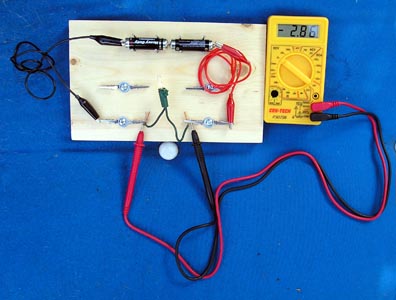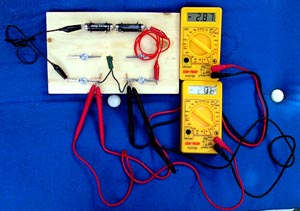
The leads from the meter are placed across the bulb to measure the voltage across the bulb.
Measurement changes the thing that is measured
Introduction
Whenever you measure the voltage across a component in a circuit or the current through a component you change the very voltage and current that you are measuring.
Material
Assembly
Connect the battery to the bulb so that the bulb glows.
To Do and Notice
Use one meter to measure the voltage across the bulb.

Touch the two leads from the meter to the two leads from the bulb.
Continue to measure the voltage with one meter while using the second meter to measure the voltage at the same time.

Notice the change in the reading of the first meter, if any, when the second meter is added.
The change in the reading of the first meter is an estimate for the amount that the voltage in the circuit changed when you added the first meter.
What's Going On?
A meter has an internal resistance. When you connect the meter to a circuit the meter's resistance is added into the circuit.
A perfect voltmeter would have infinite resistance.
Real voltmeters do not have infinite resistance and so they change the voltage across the measured component when they are used to measure the voltage across the component.
Going Further
You can measure the error produced when you insert a current meter into a circuit to measure current through a component in the same way.
Insert one current meter, note the current it measures.
Then insert a second meter in series with the first. Notice the change in current measured by the first meter. The change in current made by adding the second meter is an estimate of the change in current made when the first meter is added to the circuit.
A perfect current meter has zero resistance, it is a short circuit. Real meters have resistance that is not zero.
Math Root
If the second meter lowered the voltage across a bulb by 1%because its internal resistance was added in parallel into a circuit then we estimate that the addition of the first meter into the circuit also lowered the voltage by 1%.
|
Scientific Explorations with Paul Doherty |
|
19 Sep 2005 |